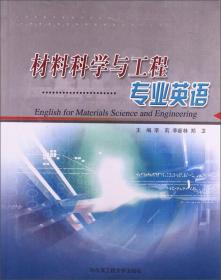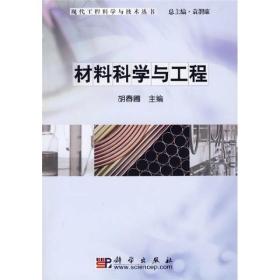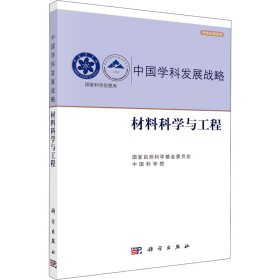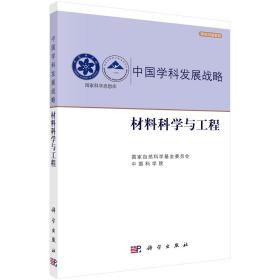
材料科学与工程专业英语
如链接显示套装,全册,标题与图不符的,请联系客服确认再下单!!!
¥ 0.7 八五品
仅1件
江苏南京
认证卖家担保交易快速发货售后保障
作者李莉、李新林、郑卫 编
出版社哈尔滨工程大学出版社
出版时间2006-08
版次1
装帧平装
货号9787810738941
上书时间2022-06-21
- 最新上架
商品详情
- 品相描述:八五品
- 65952259
图书标准信息
- 作者 李莉、李新林、郑卫 编
- 出版社 哈尔滨工程大学出版社
- 出版时间 2006-08
- 版次 1
- ISBN 9787810738941
- 定价 28.00元
- 装帧 平装
- 开本 16开
- 纸张 胶版纸
- 页数 326页
- 字数 450千字
- 正文语种 简体中文,英语
- 【内容简介】
-
《材料科学与工程专业英语》由六部分构成,一部分概述材料科学与工程学科发展,第二部分讲述材料科学的物理冶金基础内容,第三部分讲述材料的物理性能,如电、热、磁及光性能,第四部分介绍材料的力学性能,第五部分介绍材料的加工过程,最后一部分内容分别介绍了各类材料,如金属合金、陶瓷、高分子及复合材料,以及材料的选材及设计标准。
《材料科学与工程专业英语》适合作高等院校材料专业及相关专业高年级学生的专业英语教材,也可作为该类专业的研究生以及从事相关领域的教学、科研和工程技术人员的自学用书。 - 【目录】
-
Part1IntroductiontoMaterialsScienceandEngineering
ChapterIIntroduction
1.1HistoricalPerspective
1.2ImportanceofMaterialsScienceandEngineering
1.3AdvancedMaterials
1.4ModernMaterialsNeeds
Part2PhysicalFoundationsofMaterialsScience
Chapter2AtomicStructureandInteratomicBonding
2.1Introduction
2.2AtomicStructure
2.3ElectronsinAtoms
2.4ThePeriodicTable
2.5AtomicBondinginSolids
2.6PrimaryInteratomicBonds
Chapter3TheStructureofCrystallineSolids
3.1Introduction
3.2CrystalStructures
3.3CrystallogaphicDirections
3.4CrystallineandNoncrystallineMaterials
Chapter4ImperfectionsinSolids
4.1Introduction
4.2PointDefects
4.3MiscellaneousImperfection
4.4GrainSizeDetermination
Chapter5Diffusion
5.1Introduction
5.2DiffusionMechanisms
5.3Steady—StateDiffusion
5.4Nonsteady—StateDiffusion
5.5FactorsThatInfluenceDiffusion
Chapter6PhaseDiagrams
6.1Introduction
6.2DefmitiosandBasicConcepts
6.3Phases
6.4PhaseEquilibrium
6.5EquilibriumPhaseDiagrams
6.6InterpretationofPhaseDiagrams
Chapter7PhaseTransformationsinMetals
7.1Introduction
7.2PhaseTransformations
7.3MicrostrueturalandPropertyChangesinIron—CarbonAlloys
7.4MechanicalBehaviorofIron—CarbonAlloys
Part3PhysicalPropertiesofMaterials
Chapter8ElectricalProperties
8.1Introduction
8.2ElectricalConduction
8.3EnergyBandDiagramsandNumberofChargeCarriers
8.4ClassificationsofConductors
8.5IonicConductionMechanisms
8.6EffectsofDefectsandImpurites
8.7SupercondUctivity
Chapter9ThermalProperties
9.1Introduction
9.2CoefficientofThermalExpansion
9.3HeatCapacity
9.4ThermalConductionMechanisms
9.5ThermalStresses
Chapter10MagneticProperties
10.1Introduction
10.2BasicConcepts
10.3Ferromagnetism
10.4CommonMagnets
Chapter11OpticalProperties
11.1Introduction
11.2OpticalProperties
11.3InteractionsofLight'withSolids
11.4AtomicandElectronicInteractions
I1.5OpticalPropertiesofMetals
11.6OpticalPropertlesofNon—Metals
11.7ApplicationsofOpticalPhenomena
Part4MechanicalPropertiesofMaterials
Chapter12MechanicalPropertiesofMetals
12.1Introduction
12.2ConceptsofStressandStrain
12.3ElasticDeformation
12.4TensileProperties
Chapter13DislocationsandStrengtheningMechanisms
13.1Introduction
13.2DislocationsandPlasticDeformation
13.3MechanismsofStrengtheningha'Metals
13.4RecoVery,RecrystallizationandGrainGrowth
Chapter14Failure
14.1Introduction
14.2Fracture
14.3Fatigue
14.4Creep
Capter15CorrosionandDegradati6n
15.lIntroduction
15.2NatureofCorrosion
15.3EffectFactorsofCorrosion
15.4TypesofCorrosion
15.5DeterminationofCorrosionCharacteristics
15.6Corrosioncontrol
Part5Processing
Chapter16ThermalProcessingofMetalAlloys
16.1Introduction
16.2AnnealingProcesses
16.3HeatTreatmentofSteels
16.4PrecipitationHardening
Part6MaterialsandDesign
Chapter17MetalAlloys
17.1Introduction
17.2FabricationofMetals
17.3FerrousAlloys
17.4NonferrousAlloys
Chapter18Ceramics
18.1Introduction
18.2CeramicStructures
18.3CeramicPhaseDiagrams
18.4MechanicalProperties
18.5ApplicationsofCeramics
Chaper19Polymers
19.1Introduction
19.2PolymerizationReactions
19.3Types0fPolymers
19.4StrengtheningMechanisms
Chapter20Composites
20.1Introduction
20.2ClassificationsofComposites
20.3Particle—ReinforcedComposites
20.4Fiber—ReinforcedComposites
20.5StructuralComposites
Chapter21MaterialsSelectionandDesignConsiderations
21.1Introduction
21.2ThePropertySpectrum
21.3SelectionofMaterials
21.4DesignwithMaterials
点击展开
点击收起
相关推荐
— 没有更多了 —


















以下为对购买帮助不大的评价